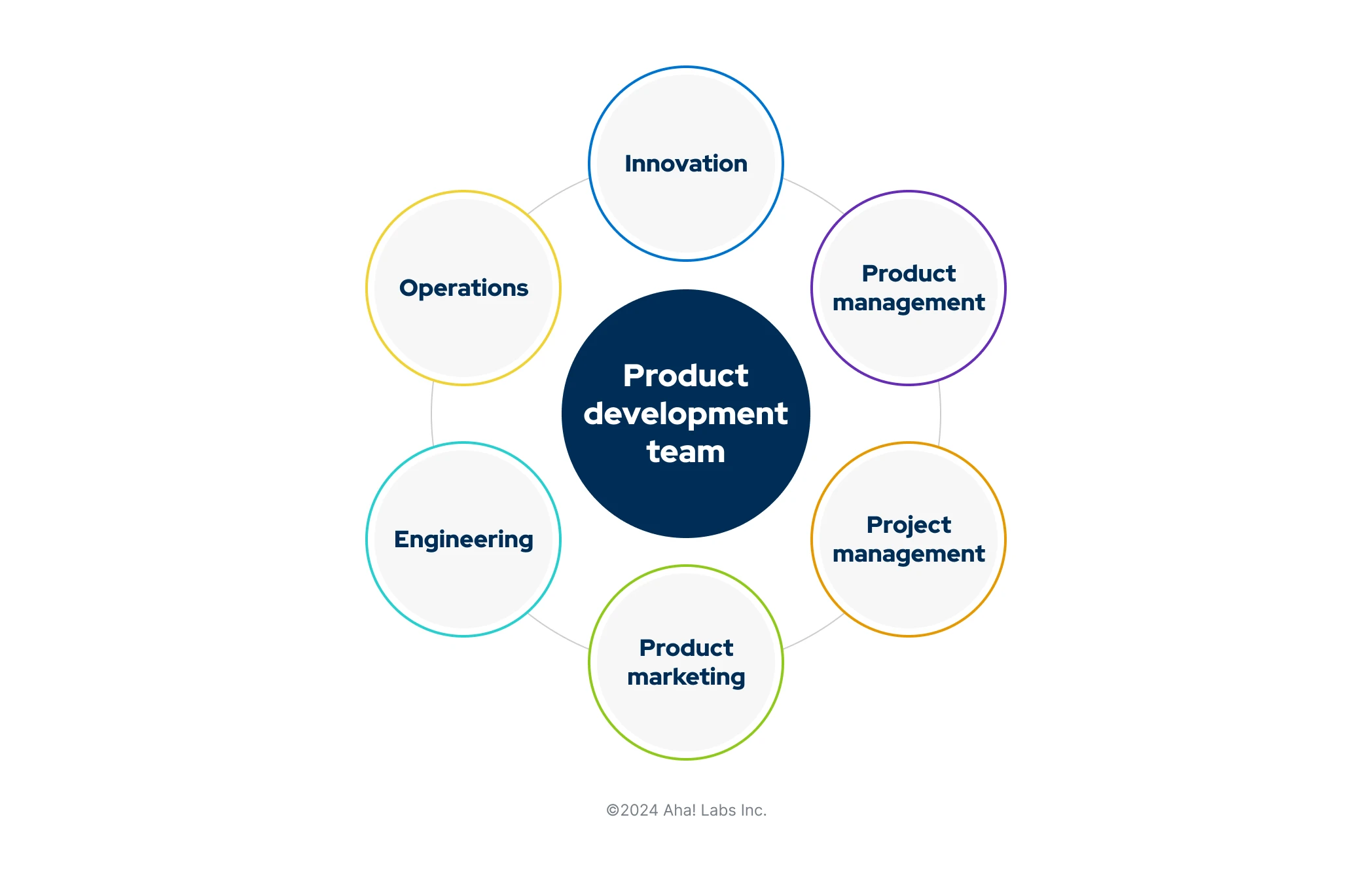How to structure your product team for success
Last updated: December 2024
Behind every great product is a great product development team. These product teams are responsible for understanding customer needs, creating something new, and bringing it to market. Besides choosing what to build, they communicate the benefits and measure product performance — crucial duties within any company. The ultimate goal is to deliver value to customers and support the business throughout the product development lifecycle.
Align everyone around your product strategy — try Aha! Roadmaps now.
Product development refers to the entire process of transforming an idea into a lovable product. It encompasses everything from capturing raw concepts and prioritizing what to build to iterating and measuring success.
It makes sense, then, that you need a dedicated group to achieve this important and interconnected work. Each member of the product team contributes their own subject matter expertise and collaborates with the rest of the organization to create products that delight customers.
Read on to learn more about the different functions that make up a product team and how to structure your organization for product development success.
What is a product team?
A product team is a cross-functional group that collaborates to define, develop, and deliver a product that meets customer needs and business goals. The team works together to align on the product strategy and carry that through everything from new product idea exploration to agile development — ensuring what you build delivers the most value.
At a basic level, core product groups typically include product management, UX, and engineering team members. But many companies include representatives from innovation, project management, product marketing, and operations as well. That means product teammates collectively own the product's direction, but do not necessarily report to the same manager or function.
Smaller startups and newer companies, for example, might not have dedicated product teams. Instead, a product manager or business leader will spearhead product development efforts and bring in cross-functional stakeholders as needed.
But some larger or more mature organizations try to get away with this, too, letting each functional group work in a silo and complete tasks for its specific stage of the product lifecycle. The problem with this approach is that teams can have divergent goals or sets of priorities. And communication might be irregular or inconsistent. This makes it difficult to align everyone working on the product around what customers need and how you will work together to deliver it.
Collaboration is key. Building a product that delights users at every touchpoint of the customer journey requires clear ownership and a solid understanding of what each role on the product team entails. No matter the products or offerings you are responsible for, delivering a Complete Product Experience (CPE) is what matters in the end. By integrating diverse perspectives and gaining a holistic understanding of every customer touchpoint, you can make better decisions about the product and deliver an exceptional user experience.
Related:
What does a product team do?
The exact structure and responsibilities of your product organization will vary depending on your company's type and maturity, specific offerings, release cadence, and preferred methodologies.
But if you want to set up your product team to successfully deliver a CPE, it is a good idea to include the six main functions we mentioned above. Here is an overview of each, along with the main responsibilities and common titles for these roles:
Function | Product team responsibilities | Roles |
Innovation |
|
|
Product management and user experience (UX) |
|
|
Project management |
|
|
Product marketing |
|
|
Engineering |
|
|
Operations |
|
|
Related:
What is the best way to structure your product team?
There is no one-size-fits-all structure when it comes to product development. You can organize your product team around the different products or product lines in your organization, the functional area each team supports (whether that is a product feature or a customer segment), or a specific business or customer need.
Consider these questions as you think about the best way to organize your product group:
Who are your target customers? How do their needs vary?
Which business goals do you want to achieve?
Are there multiple products or product lines to manage?
What resources will you dedicate to each team?
No matter which type of team structure you choose, a product leader typically leads the cross-functional product team. They are involved in every stage of the product development lifecycle — making them well suited to work with other functions to evaluate ideas, define release plans and timing, and clarify exactly what should be built.
Need help deciding how to structure your product team? Here is a quick rundown of a few common ways that organizations structure their product teams:
Product team structure | Description |
By product or product line | A product leader manages a broad range of initiatives for one product or product line — conducting customer research, maintaining the product roadmap, and partnering with engineering to build new functionality. This type of structure is helpful for large organizations with multiple offerings. |
By product feature | A product leader owns a discrete focus area and communicates with other product managers about cross dependencies. The CPO typically ensures visibility and cohesion across the broader product organization. This structure is particularly useful for organizations with complex offerings. |
By cross-functional collaboration | Sometimes called product squads, these groups are especially popular among agile development teams. They are often comprised of a product owner or product manager, a coach or scrum master, developers, and sometimes QA folks. This approach works well at large organizations with sufficient team members and resources to justify creating many smaller teams. |
By customer segment | Product managers are responsible for different customer groups, each with different needs and expectations (e.g., enterprise customers vs. small and midsize businesses). This structure often makes sense for companies with products that serve vastly different markets or industries. |
By customer journey stage | Product managers focus on enhancing a product's value during a particular stage of the customer journey, including onboarding, adoption, and continued use. This approach works well at organizations with a robust product offering and the resources to tackle each customer journey phase in depth. |
By performance metrics | Each product leader owns a set of specific product goals or KPIs and works across product features to achieve better results. This structure can work well if you have a mature product with established KPIs that reflect value created for customers and the business alike. |
By agile development methodology | Your organization's chosen development methodology can impact your product team's ideal structure. For example, scrum prescribes a team structure comprised of a product owner, scrum master, and development team. The Scaled Agile Framework®, on the other hand, is designed for large organizations. Its team structures are similarly complex, with a number of prescribed roles organized into three levels: team, program, and portfolio. |
Regardless of which methodology you follow, you will want to organize your team in a way that sets them up for success (as you define it). In general, aim for efficient use of resources and effective collaboration.
And remember: Every product development team needs well-defined roles and a sound structure. But it all starts with a clear vision and strategy that describes what you are trying to achieve. This is how you know where you are headed, why, and how you will get there — no matter how your team happens to be organized.
Tools to support product team collaboration
The best product teams work closely together and with the rest of the organization, keeping an active feedback loop. This might mean that product leaders have regular check-in meetings with the support team to hear the latest customer feedback. Or that project managers collaborate with the finance and legal teams early in the project planning process to identify any bottlenecks that might slow the team's progress.
Related:
The right tools can bolster this type of collaboration and help work move smoothly between teams throughout the stages of product development. These might include:
Centralized product strategy
Customer ideas portals
Integrated agile development tools
Successful teams use purpose-built product development software to align around a shared sense of purpose. With the Aha! software suite, you have everything you need to bring your product strategy to life. Curious to see how it works? Try it out yourself.



